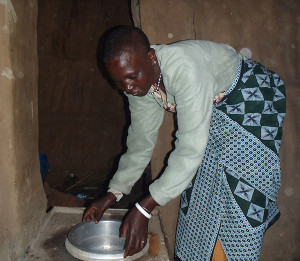Conditions for sustained adoption of cookstoves and reliable health improvement case study: The Maasai Stoves and Solar Project of the International Collaborative for Science, Education, and the Environment
One of the main goals of cookstoves is to improve health. Because the widespread use of medical examinations to monitor health improvements is not practical, our community uses smoke reduction as the most feasible method to measure the health impacts of new cookstoves. 
Less smoke means a reduction in particulate matter and carbon monoxide, which are responsible for many health problems. But health impacts measured by smoke removal are only reliable when women continue to use their new stoves well and don’t return to traditional methods for a significant fraction of their cooking. Over the past four years, our project has been working with Maasai mothers in Tanzania with a strong focus on designing and manufacturing cookstoves. We are finding that the stove has a high sustained-adoption rate. We have asked ourselves why this is so and why, when there are now explicit behavior change programs being introduced, we do not need one.
Why is it that the women never abandon this particular stove? The key, we have found is having a stove that the women actually want. They want it because it is safer for themselves and their families and they are tired of smoky homes. They want it because it reduces the menial labor of gathering firewood. They want it because it is convenient for all the kind of cooking they do and it’s faster.
To design the stove we worked alongside Maasai mamas for a year and a half trying out different prototypes and listening to their assessments. For us, the breakthrough for smoke reduction and safety was the use of a chimney. The smoke is channeled up through the chimney away from the lungs of Maasai mamas and children and the bricks of the stove and chimney stay cool so that children don’t burn themselves. Our design requires some manufacturing and construction so we have employed locals to do all the firebox manufacturing and teams of Maasai women are organized to build the stoves into the homes of new clients. As the project expands, the women experts train new teams of women. The desirability of the stove, and the involvement of Maasai women in its distribution and installation together, have led to an integration of the stove into the social fabric. This has guaranteed total sustained adoption and therefore measurable health impact.
- Please visit the website of the Maasai Stoves and Solar Project
- Contact us in Tanzania or the US: Kisioki Moitiko, +255 684 14 56 80, kisiokim@gmail.com; Robert V. Lange +1 508 735 9176, rbtvl@aol.com




{ 1 comment… read it below or add one }
Request for mfg know how to re think for sad project subject to support from your end with order support to reduced cost. But I have studied that WHO & no of organization are working with my photographs wooden cooking stoves for less smoke.Request your support as per your recent modified stoves.Considering to afford the mfg cost.